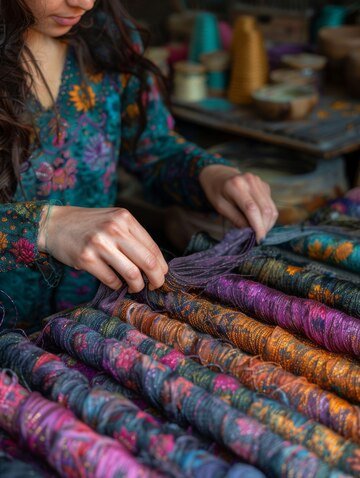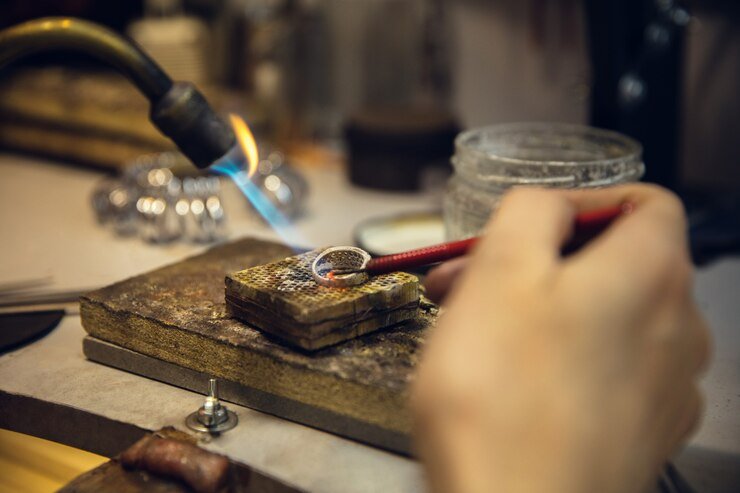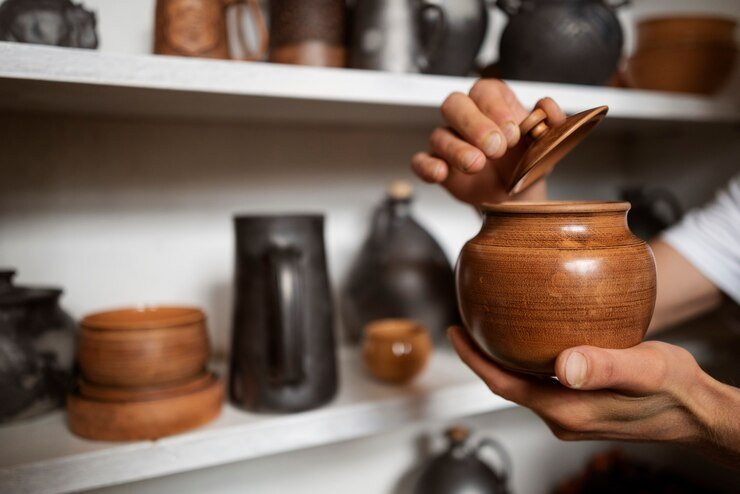Reviving Heritage: Traditional Indian Crafts in Modern Markets
Reviving Heritage: Handloom Textiles in Modern Markets

Introduction to Handloom Textiles :
Handloom textiles hold a significant place in Indian culture, embodying centuries-old traditions of craftsmanship passed down through generations. These textiles are woven painstakingly by hand, often using techniques that date back millennia. Each piece tells a story of skill, artistry, and cultural heritage, making them not just fabrics but embodiments of India’s rich textile legacy.
Adapting Tradition to Modern Tastes
In recent years, there has been a remarkable resurgence of handloom textiles in contemporary fashion. Designers are increasingly drawing inspiration from traditional motifs and weaving techniques to create modern interpretations that appeal to today’s fashion-conscious consumers. This fusion of tradition and modernity has breathed new life into handloom textiles, making them relevant and desirable across the globe.
Market Trends and Consumer Appeal
There is a growing global demand for sustainable and ethically sourced textiles, driven by consumer awareness and environmental consciousness. Indian handloom textiles, known for their use of natural fibers and eco-friendly production methods, perfectly align with these trends. Discerning consumers are now seeking out handloom products not only for their aesthetic appeal but also for their positive impact on local communities and the environment.
Conclusion: Embracing Heritage in Every Thread
Handloom textiles continue to captivate with their timeless elegance and cultural richness. By choosing handloom products, consumers not only adorn themselves with exquisite fabrics but also contribute to the preservation of India’s artisanal heritage. Let us celebrate and support these traditional crafts, ensuring that their legacy thrives for generations to come.
Reviving Heritage: Indian Pottery in Modern Markets

Introduction to Indian Pottery :
Indian pottery reflects a diverse array of styles and techniques, varying across different regions and communities. From the intricate designs of terracotta in rural villages to the ornate patterns of glazed ceramics in urban centers, pottery in India is deeply rooted in its cultural and historical contexts. It serves not only functional purposes but also holds symbolic significance in rituals and everyday life.
From Tradition to Contemporary Art
Modern Indian potters are adeptly blending ancient pottery techniques with contemporary aesthetics, creating pieces that appeal to today’s art enthusiasts and collectors. These artisans innovate while respecting tradition, producing pottery that merges timeless craftsmanship with modern design sensibilities. Their work serves as a testament to the adaptability and enduring allure of Indian pottery in a globalized world.
Environmental Impact and Sustainable Practices
Pottery, inherently sustainable due to its use of natural materials and low carbon footprint, aligns well with modern eco-conscious values. Traditional pottery methods prioritize local resources and minimal waste, contributing positively to environmental conservation efforts. By supporting handmade pottery, consumers not only acquire unique pieces of art but also promote sustainable practices that benefit both artisans and the planet.
Conclusion: Celebrating Heritage Through Clay
Indian pottery continues to captivate with its artistic finesse and cultural significance. Through their creations, artisans preserve and propagate India’s rich pottery traditions, ensuring that these crafts thrive in contemporary markets. Embracing handmade pottery is not just a choice of décor but a commitment to honoring heritage and supporting artisanal communities worldwide.
Jewelry Making: Ancient Craft in Modern Times

Introduction to Indian Jewelry
Jewelry making in India has a history as intricate and varied as the pieces themselves. From the majestic Kundan and Polki jewelry of the Mughal era to the delicate filigree work of South India, Indian jewelry reflects the country’s diverse cultures and craftsmanship. It serves as adornment, status symbol, and cultural expression, embodying centuries-old traditions passed down through generations.
Craftsmanship and Design Innovation
Today, Indian jewelers are blending traditional jewelry-making techniques with contemporary designs, catering to a global audience that values both luxury and uniqueness. These artisans meticulously craft each piece, incorporating ancient motifs and gemstones into modern settings that resonate with modern tastes. The result is jewelry that not only dazzles with its beauty but also tells stories of India’s cultural splendor.
Ethical Sourcing and Cultural Preservation
Ethical sourcing is paramount in the jewelry industry, ensuring that materials are responsibly procured and artisans are fairly compensated. Indian jewelers uphold these values by sourcing gemstones and metals ethically and by promoting transparency in their supply chains. Additionally, through their designs, they preserve cultural integrity, showcasing India’s artistic heritage to the world with pride and reverence.
Conclusion: Adorning Modern Lives with Ancient Glamour
Indian jewelry continues to enchant and inspire, transcending borders and cultures to adorn modern lives with timeless glamour. By supporting Indian jewelers, consumers not only acquire exquisite pieces of jewelry but also contribute to the preservation of India’s rich cultural legacy. Let us cherish and celebrate these treasures, ensuring that they continue to shine brightly for generations to come.
Artisanal Crafts: Upholding Tradition in Home Décor

Introduction to Indian Home Décor Crafts
Indian home décor crafts encompass a wide range of traditional arts and crafts, each offering a glimpse into the country’s vibrant cultural tapestry. From intricately woven textiles to intricately carved woodwork and exquisite metalwork, these crafts enhance living spaces with their beauty and craftsmanship. They reflect the diversity of India’s regions and communities, each contributing unique styles and techniques to the world of home décor.
Modern Applications of Traditional Crafts
In recent years, Indian artisans have been creatively adapting traditional home décor crafts to suit contemporary interiors and lifestyles. Whether it’s incorporating traditional motifs into modern furniture designs or using sustainable materials for eco-friendly home accessories, these artisans are innovating while preserving the authenticity and charm of their craft. Their creations not only add aesthetic value to spaces but also imbue them with cultural richness and heritage.
Cultural Preservation and Artisan Empowerment
The revival of traditional home décor crafts is not just about aesthetics but also about preserving cultural heritage and empowering artisan communities. By supporting handmade home décor products, consumers contribute to the livelihoods of artisans and help sustain age-old techniques and traditions. These crafts are more than just decorations; they are tangible expressions of cultural pride and resilience.
Conclusion: Infusing Homes with Heritage
Indian home décor crafts offer a unique opportunity to infuse homes with heritage and personality. By incorporating these crafts into living spaces, consumers not only create visually appealing environments but also connect with India’s rich artistic legacy. Let us embrace and celebrate these artisanal treasures, ensuring that they continue to inspire and enrich homes around the world for years to come.
FAQs
What are traditional Indian crafts?
Traditional Indian crafts encompass a wide range of artistic disciplines including handloom textiles, pottery, jewelry making, wood carving, metalwork, and more. These crafts are often characterized by their rich cultural heritage, intricate designs, and skilled craftsmanship passed down through generations.
Why are traditional Indian crafts important?
Traditional Indian crafts are important because they preserve cultural heritage, promote sustainable practices, and support artisan livelihoods. They offer a glimpse into India’s diverse cultural tapestry and provide unique, handmade alternatives in today’s mass-produced market.
How are traditional Indian crafts adapting to modern markets?
Traditional Indian crafts are adapting to modern markets by integrating contemporary designs, styles, and functionalities. Artisans are collaborating with designers to create products that appeal to contemporary tastes while preserving traditional techniques and cultural integrity.
Where can I buy authentic traditional Indian crafts?
Authentic traditional Indian crafts can be purchased from various sources including artisan cooperatives, craft fairs, online marketplaces specializing in handmade products, and directly from artisan workshops. It’s important to verify the authenticity and ethical sourcing practices of the seller.
What are the benefits of purchasing traditional Indian crafts?
Purchasing traditional Indian crafts supports artisan communities, preserves cultural heritage, promotes sustainable practices, and offers consumers unique and handmade products with artistic value. It also fosters a connection to history and tradition through tangible artifacts.
How can I ensure the ethical sourcing of traditional Indian crafts?
To ensure ethical sourcing of traditional Indian crafts, look for certifications such as Fair Trade or labels indicating sustainable practices. Buy from reputable sellers who transparently disclose their supply chain and demonstrate a commitment to fair wages and working conditions for artisans.
Are traditional Indian crafts environmentally friendly?
Many traditional Indian crafts are environmentally friendly due to their use of natural materials and sustainable production methods. For example, handloom textiles often use organic fibers and natural dyes, while pottery and metalwork prioritize local resources and minimize waste.
How can I support the revival of traditional Indian crafts?
You can support the revival of traditional Indian crafts by purchasing handmade products directly from artisans or ethical retailers, spreading awareness about their cultural significance, and advocating for policies that protect artisan rights and promote sustainable practices.
What role do traditional Indian crafts play in global fashion and décor trends?
Traditional Indian crafts influence global fashion and décor trends by offering unique designs, textures, and cultural narratives that resonate with consumers seeking authenticity and individuality. They inspire designers worldwide to incorporate ethnic elements into contemporary styles.
Can traditional Indian crafts compete in today’s modern market?
Yes, traditional Indian crafts can compete in today’s modern market by leveraging their authenticity, craftsmanship, and unique appeal. They cater to consumers’ growing interest in sustainability, ethical consumption, and handmade products that tell a story of cultural heritage.
